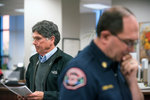


A bond of $17.995 million was roundly rejected by voters on Tuesday night.
The bond — which needed 60 percent of the vote to pass — was opposed by 68.56 percent of the 1,199 ballots cast in the election.
Napavine Superintendent Rick Jones said he was discouraged to see the outcome, but said that he knew the comprehensive plan to upgrade facilities was a costly one. He commended the groups of people who worked to put the bond together and promote it.
“They have been an inspiration to me through this whole process and I feel badly for them because of the work they did,” Jones said.
The superintendent said the district did not yet have a backup plan if the bond failed, and said the school board would discuss the outcome at its next meeting to decide what steps should be taken. He said the problem of aging facilities — especially those of the old portables housing middle school students — would not go away.
“I will follow (the school board’s) direction on what they want to do, but I’m sure that there will be a good conversation about the outcome and I would imagine that we will have some more community conversations going forward to determine what would be the best next steps,” he said.
If the bond had passed, an additional tax impact of an estimated $2.53 per $1,000 in assessed value would have been added to the 93 cents taxpayers are currently paying on an existing bond, raising the total to $3.46 per $1,000.
The large increase in tax impact had some opponents concerned, as recently approved sewer rate hikes and other possible cost increases were said to be too much for the community of Napavine.
John Hylton, a former school board member and opponent of the bond, said that, moving forward, the bond committee and the school district need to better understand the dynamics and demographics of the city.
“It actually turned out the way I thought it would turn out and now I think they need to take a step back and I think they now need to relook at the numbers to see what it would take to actually pass a bond,” he said.
He said although the plan was comprehensive, it put too much of a tax on community members, and he felt a bond that would remain under $2 would have a better chance of passing.
“I hope the next one passes, but we need to make it a little more realistic,” Hylton said, adding that he would like to be on the next bond committee to help design an affordable plan.
After results were announced, Jones said he knew there was a fair amount of community concern for the increase in taxes. He said the taxpayers obviously agreed that the money requested was too large of a sum.
“I knew that the price tag was challenging,” Jones said of the bond. “Of course this is what the voters get to do, they get to decide. I have to respect that.”
The bond, which would have come with a state match of $9.6 million to add up to a total of $27.605 million, would have remodeled the high school by adding nine classrooms. Plans for the remodel would have redesigned the core area of the high school, enlarged existing commons area, and would have moved the library from its current location to the center of the campus to be used by both middle and high school students. It would have also allowed the Napavine School District to add a middle school wing to house the district’s seventh- and eighth- grade students who currently attend classes in portable units.
The additional middle school wing would have included seven classrooms, a servicing kitchen, a small student commons area, extra locker rooms and an additional gym.
The main purpose was to help update aging facilities after a bond committee of community members addressed growth issues in the district, which have restricted students in prior years, Jones told The Chronicle in an earlier interview. The new building would have accommodated growth projections for the city and would have decreased the costs of maintenance, utilities and operations, supporters said.
The bond was put in place after a facilities committee studied the community’s needs for 14 months, addressing the concerns that the current school facilities were the highest priority.
The vote will be certified on May 12.